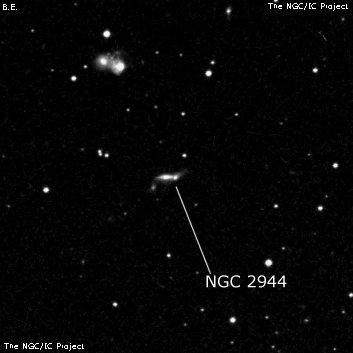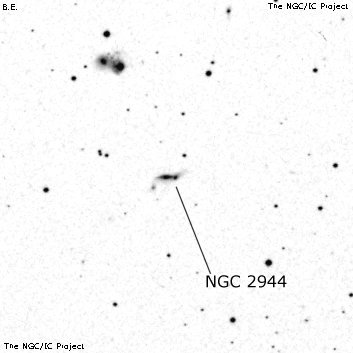NGC/IC Project Restoration Effort
(This is a very very beta version)
NGC2944


Basic Information
Location and Magnitude
Right Ascension: 9:39:18.0
Declination: +32:18:38
Constellation: LEO
Visual Magnitude: 14.0
Historic Information
Discoverer: Palisa
Year of discovery: 1886
Discovery aperture: 12.0
Observational
Summary description: F, vS, lbM
Sub-type: Sc
Corwin's Notes
=====
NGC 2944. It has seemed strange to me that just three arcmin north-following
this triple galaxy is a considerably brighter pair. Did Palisa perhaps see
one of the pair rather than the galaxy we now call N2944?
Tracking down Palisa's original observation to AN 2782, I found that his
micrometrically measured position (based on six settings) falls within
three arcsec of the GSC position of brightest of the triple. The identity is
thus certain -- but why did Palisa not see the brighter galaxies just to the
north?
Steve's Notes
=====
NGC 2944
48" (4/18/15): At 697x, this double (or possibly triple) system appeared moderately bright, very elongated 3:1 E-W, ~36"x12", weak concentration. A small roundish knot (SDSS J093916.79+321837.7 ) attached at the west end has a moderately high surface brightness and a diameter of 8"-10". On the SDSS this "knot" appears to be the core of a merged interacting companion! VV 82b is another interacting companion, just 27" SE of center. It appeared extremely faint, very small, round, 10" diameter. It was only visible with averted for short periods. PGC lists a photographic mag of 18.6.
The double system Arp 129 = VV 83 = UGC 5146 is 3.5' NNE. At 697x; the eastern component appeared moderately to fairly bright, small, round, high surface brightness, ~20" diameter. A mag 12 star, superimposed on the western component VV 83a = MCG +06-21-071 is just 30" WSW. The western component of Arp 129 appeared fairly faint, fairly small, roundish, nearly even surface brightness? Although easily visible, the view is significantly impaired by the 12th magnitude star and the galaxy was only visible on the east side of the star.
18" (4/14/12): faint to fairly faint, fairly small, elongated 5:3 E-W, ~30"x18", slightly brighter core. Arp 63 is a merged double system with a third very faint companion 30" SE, which was not seen.
The double system Arp 129 lies just 3.8' NE. The eastern component (MCG +06-21-072) appeared faint, very small, round, 15" diameter. There is a relatively bright star superimposed on the western component (MCG +06-21-072), making confirmation difficult.
17.5" (4/25/98): extremely faint, very small, elongated 2:1 ~E-W, slightly brighter core but overall low surface brightness. Collinear with two mag 13 stars 3.4' and 4.4' NE. This double system was not resolved under noticeably hazy sky conditions and soft seeing. UGC 5146 = Arp 129, another double system, lies 3.7' NE.



